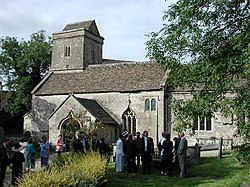Swainswick
| Swainswick | |
| Somerset | |
|---|---|
| File:Upper Swainswick.jpg Upper Swainswick | |
| Location | |
| Grid reference: | ST756681 |
| Location: | 51°24’44"N, 2°21’5"W |
| Data | |
| Population: | 265 (2011) |
| Post town: | Bath |
| Postcode: | BA1 |
| Local Government | |
| Council: | Bath & NE Somerset |
| Parliamentary constituency: |
North East Somerset |
Swainswick is a small village in Somerset three miles north-east of Bath, just outside the city's urban area. The village is found on the A46. It is within the county's Bath Forum Hundred.[1][2]
The parish had a recorded population of 265 in 2011.
The village name was also spelled as Sweyneswik and Sweyneswick in the early 13th to 14th Century.[3]
History
The village is tied in with the legend of Bladud or Blaiddyd, the mythical king of the Britons who was cured of leprosy in a hot spring, reclaimed his throne and founded Bath on the spot. One aspect of the legend says that he was driven out because of his disease and found employment as a swineherd at Swainswick, in which time he noticed that his pigs had found a hot spring, in which he bathed to cure his own leprosy.
Another version of the story says that Bladud's pigs became infected and diseased and that his search for food for the pigs brought him to Swainswick, where a farmer advised him to look for acorns on the far side of the river (possibly the Lam Brook at the bottom of the Lam valley). There the swine found hot mud in which to wallow and when the king scraped them clean he found their skin was cleansed and cured.[4]
It is possible that the name of Swainswick is derived from Sweyn Forkbeard (c. 960 – 3 February 1014), who along with his troops is said to have stayed in Bath in 1013 whilst conducting a full scale invasion of Briton before becoming King, according to the contemporary Peterborough version of the Anglo-Saxon Chronicle (also called the Laud Manuscript). The chronicles tell that "Then went King Sweyne thence to Wallingford; and so over Thames westward to Bath, where he abode with his army. Thither came Alderman Ethelmar, and all the western thanes with him, and all submitted to Sweyne, and gave hostages. When he had thus settled all, then went he northward to his ships; and all the population fully received him, and considered him full king."[5]
The Domesday Book of 1086 records that Swainswick (Swayneswycke) was held by Nigel de Gournay, who would have won his lands in Englishcombe, Twerton, Swainswick and Barrow Gurney by fighting for William the Conqueror. His original home was probably Gournay, which was half-way between Dieppe and Paris. Thomas de Gournay was involved with the murder of King Edward II at Berkeley Castle in 1327.[6]
The three-mile, £45 million A46 dual-carriageway Batheaston/Swainswick bypass opened in summer 1996.
Parish church

The Church of St Mary dates from the 12th century. It has been designated a Grade II* listed building.[7]
The church contains monuments to the parents of William Prynne, the Puritan parliamentarian, who was born in the village in 1600. There is a ledger slab of John Wood the Elder, architect of Georgian Bath. The tomb probably contains the bodies of John Wood the Younger and his wife.
Outside links
| ("Wikimedia Commons" has material about Swainswick) |
References
- ↑ Reverend John Collinson (1791). The History and Antiquities of the County of Somerset. 1. pp. 97. ISBN 978-1-171-40217-6. https://books.google.com/books?id=EosgAQAAMAAJ&pg=PA97.
- ↑ "Somerset Hundreds". GENUKI. http://www.genuki.org.uk/big/eng/SOM/Miscellaneous/. Retrieved 9 September 2011.
- ↑ "National Archives Entry" The National Archives
- ↑ Self, Janice "Swainswick Tourist Information" aboutbritain.com
- ↑ Anglo-Saxon Chronicle Laud Chronicle (1013)
- ↑ Manco, J. (1995) "The Parish of Englishcombe: A History", pp. 2, 4.
- ↑ National Heritage List 1232679: St Mary's Church